The Client
In the role of an instructional designer, I worked in collaboration with the Department of Psychiatry within the University of Colorado's School of Medicine at the Anschutz Medical Campus (CU SOM AMC), in order to help design and develop an asynchronous online course for the Colorado Behavioral Health Administration (BHA). This course is one of many that will soon be housed in the BHA’s learning management system, which provides free online educational resources for behavioral health providers working in Colorado.


The Purpose
Under the direction of the BHA, the course was designed to support behavioral health providers in their ability to manage their everyday work-related stress and, hopefully, prevent career burnout. This was partly in response to the BHA's 2020 Behavioral Health Needs Assessment, which indicated that providers throughout the state are struggling to take care of their own mental health needs, largely as a result of high stress and demanding work environments. While this course is certainly not a fix-all for the many challenges these professionals face, the hope is that it can provide them with some beneficial tools and resources to help them better manage their everyday stress, both as individuals and members of a collaborative clinical team. The aim is for learners to walk away from the course feeling more aware, skilled, and confident in their ability to face their stress head-on, so they can focus on the more rewarding aspects of their job and, hopefully, flourish and sustain in their career. If, in addition, they can have a little fun while they're at it... wouldn't that be a nice bonus! After all, a course on stress management should be stress-relieving, not stress-inducing, right?

The Team
I had the immense fortune of working with an incredible team on this project. Mandy Doria, LPC, NCC, TCTSY-F, RYT-500 and Leslie Choi, CPNP, PMHNP-BC, two highly experienced clinicians and CU SOM AMC faculty, served as the subject matter experts. Their deep knowledge, experience, and passion for our course topic and learner population made them a dream to collaborate with, and I sincerely appreciate their patience and willingness to work with me as a relatively inexperienced instructional designer. I also had the pleasure of working with Ben Jutson, who supervised the project and helped me navigate the complexities of working with subject matter experts, learning new software, and surviving peer reviews, among many other things.

The Project
I was assigned to this project in January, 2024 with instructions to collaborate with Mandy and Leslie on designing and developing an asynchronous, self-paced online course that could be completed by the average learner in about 90 minutes. The plan was to condense and reimagine content contained within an existing online program called Past the Pandemic, which was initially developed by Mandy and Leslie to help health care workers stay well and build stress resiliency while responding to the COVID-19 pandemic. Still ongoing, this multi-part program provides community support and delivers asynchronous content through roughly four total hours of video-based modules, plus supplemental materials and activities (toolkit, reflections, etc.). Designed to support the mental health needs of the health care workforce as a whole, topics include things like stress awareness, stress buffering through supportive relationships, sleep hygiene, mindfulness practices, and setting healthy boundaries.
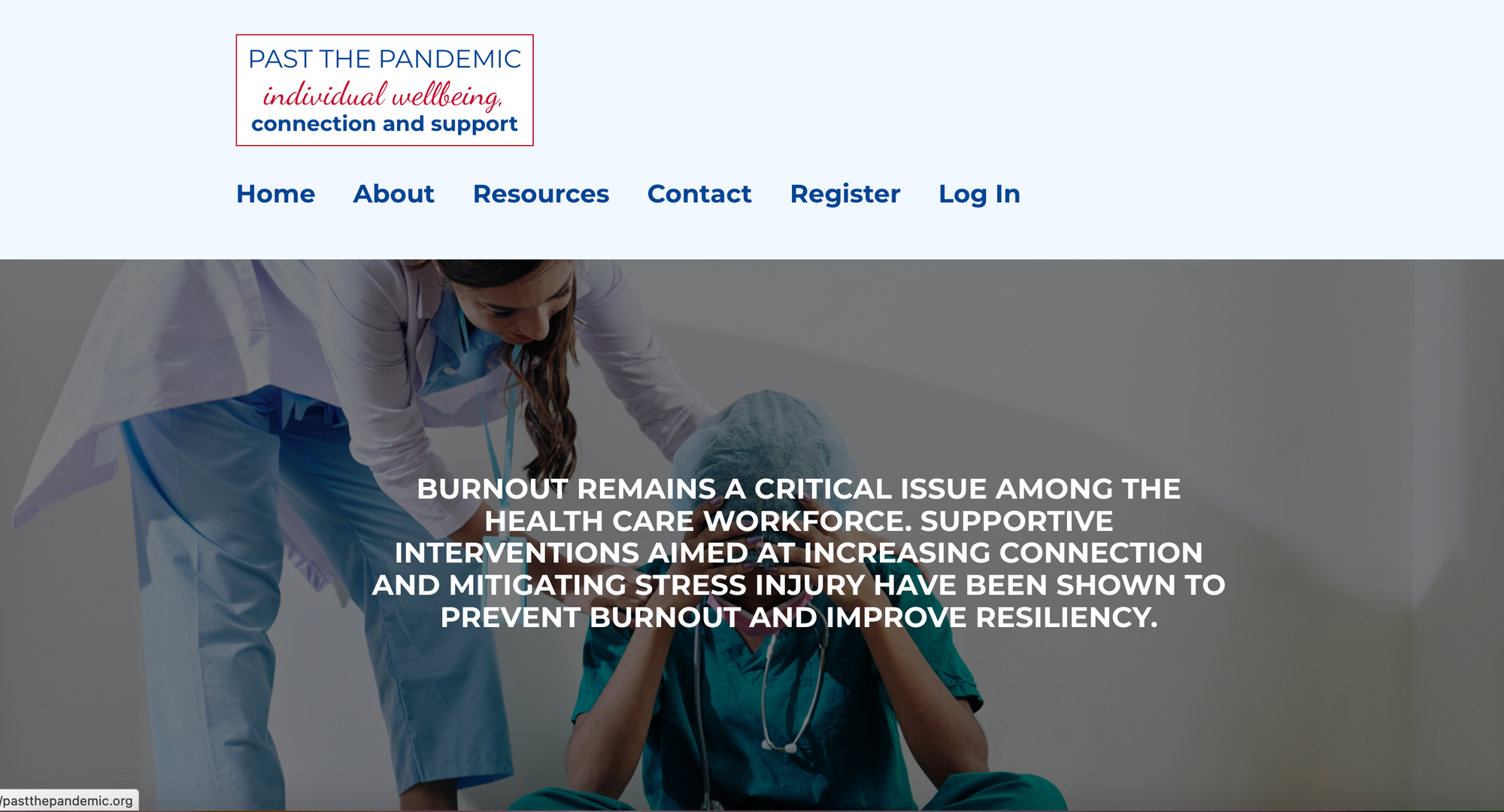
In contrast, our project needed to consider and cater to the unique needs of a more narrowed audience of behavioral health providers. This required adjusting the scope, content, and tone of our materials to more appropriately match the knowledge, experience, and challenges these particular learners are apt to carry with them into the course. For example, we recognized that most behavioral health providers are likely already well-versed in basic stress management frameworks and strategies, given their training and everyday work with clients/patients. As a result, we tried to be very careful in choosing content that would feel substantive and meaningful to this learner population, and deliver it in a way that would be approachable and respectful. For this reason, instead of framing our coursework as new information, we chose to portray it more as a means of refreshing, expanding, and solidifying learners' existing understanding, with the intention of helping them take better care of themselves while they care for others. Likewise, we chose to speak to them from the perspective of a fellow colleague, as opposed to an authority figure, in order to try to cultivate a more conversational, collaborative tone for the course.

The result is a reflective, interactive learning experience that walks learners through the process of developing a comprehensive, personalized stress injury mitigation plan, aimed at supporting them both as individuals and valued professionals within the behavioral health field. Entitled Stress Injury Mitigation Through Collective Self-Care, the course is organized into three modules with three lessons each, and it includes elements such as
- Scenarios and activities featuring two example behavioral health providers, Lily and Michael (these elements are carried throughout the course, and many include optional audio components recorded by human readers to give them a more personal feel)
- Concrete examples and observations taken from real-life interviews with behavioral health providers working in various clinical settings
- Brief stress-relieving activities at the end of most lessons, which encourage learners to take a break from the content and practice "completing the stress cycle"
- Self-reflection activities developed in both Rise 360 and Storyline 360 (many give learners the opportunity to select from a list of options, enter their own responses, and print or download a PDF of their work)
- "Choose your own adventure" activities that allow learners to pick and choose topics that are most interesting to them and relevant to their life
- Interactive graphics and animated videos developed in Adobe Illustrator, Storyline 360, and Camtasia to illustrate and discuss more complex concepts and frameworks
Some examples of these different elements are provided below.
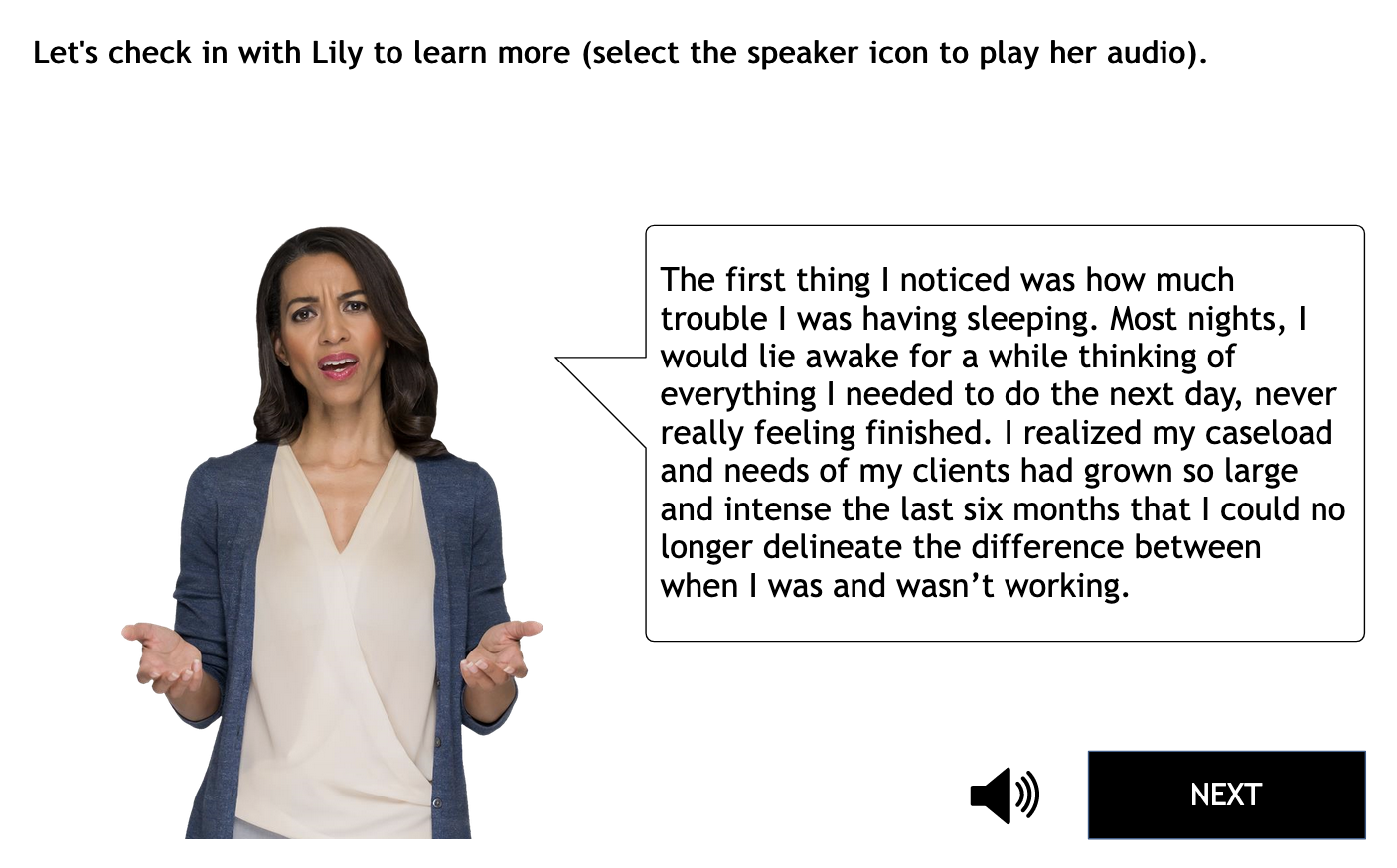
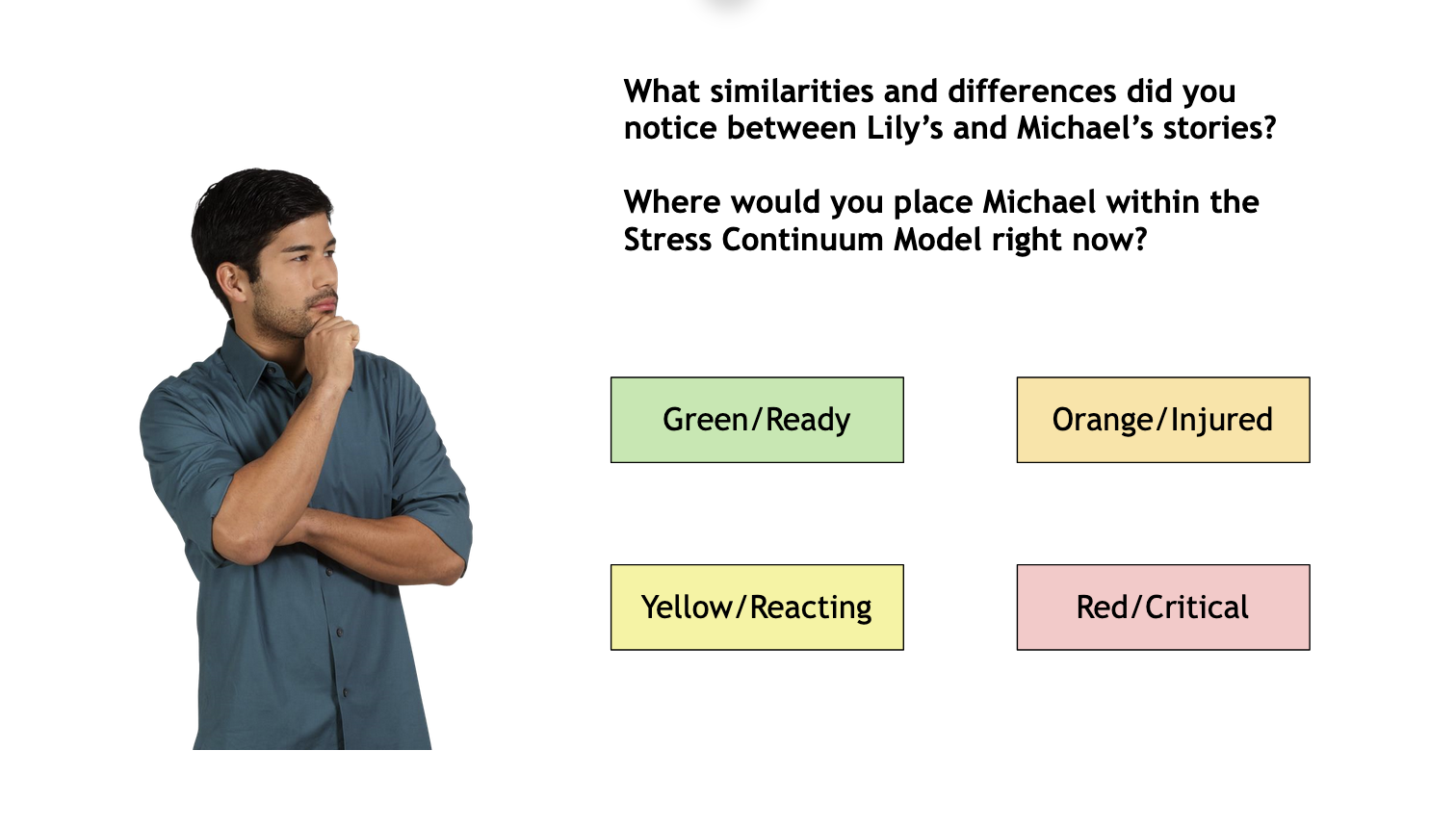

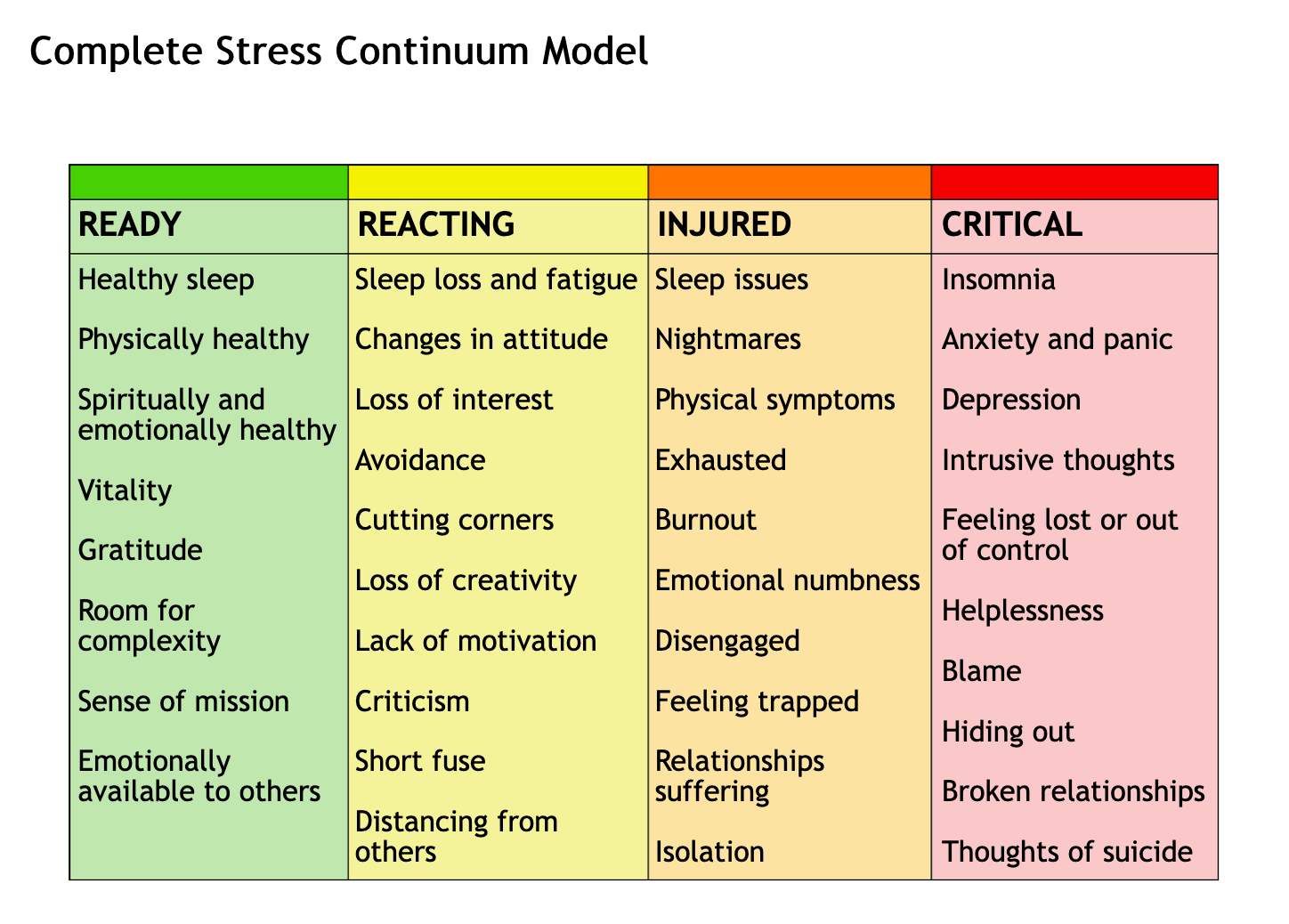
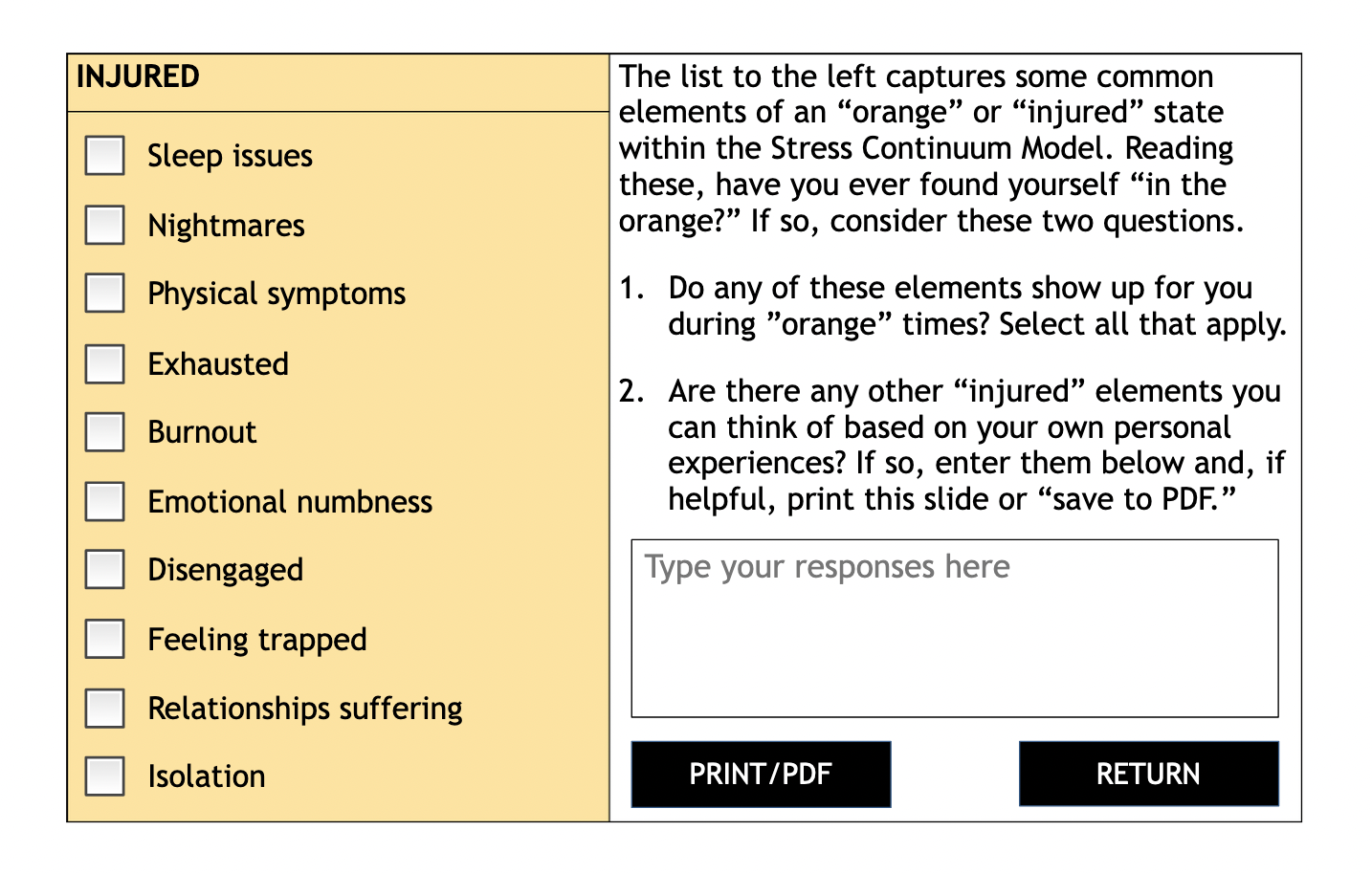
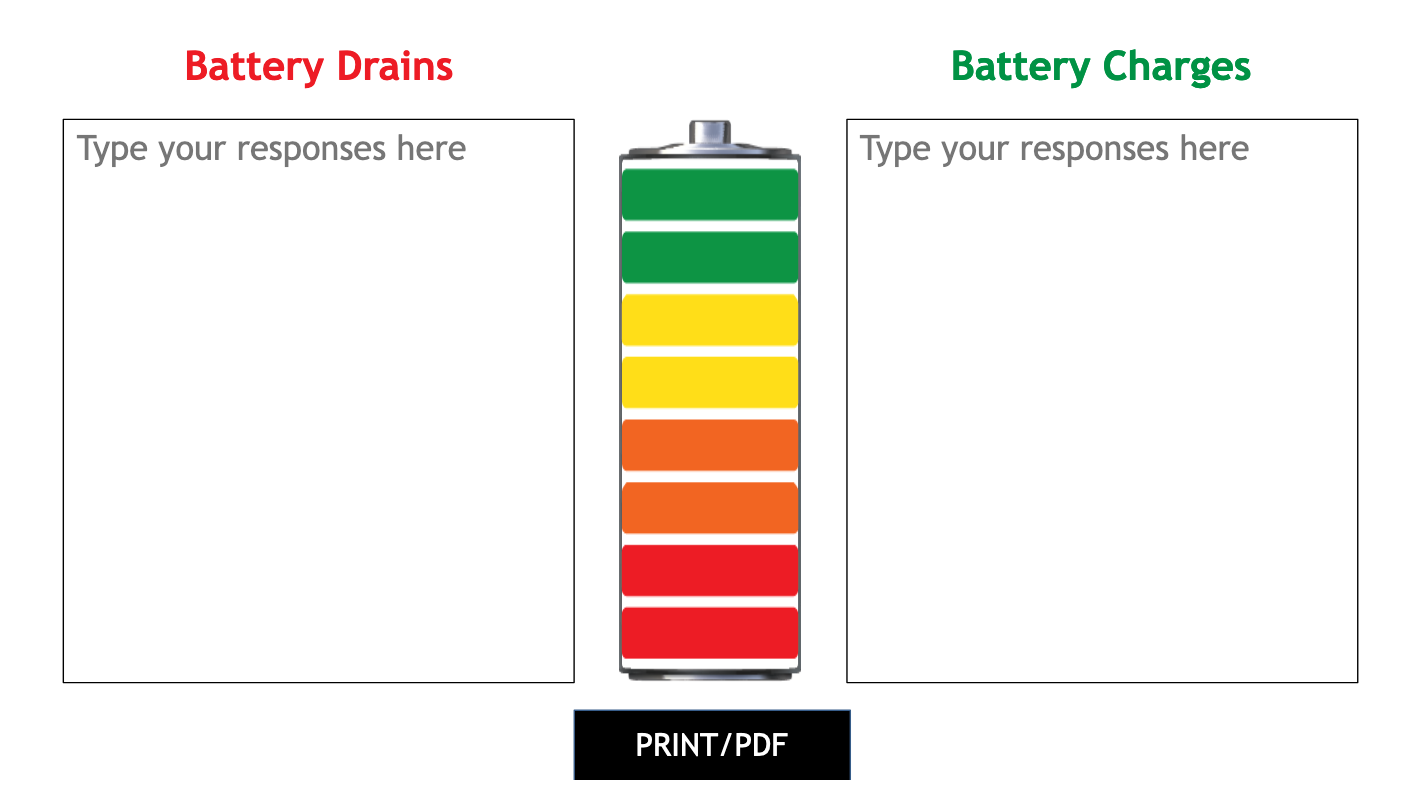
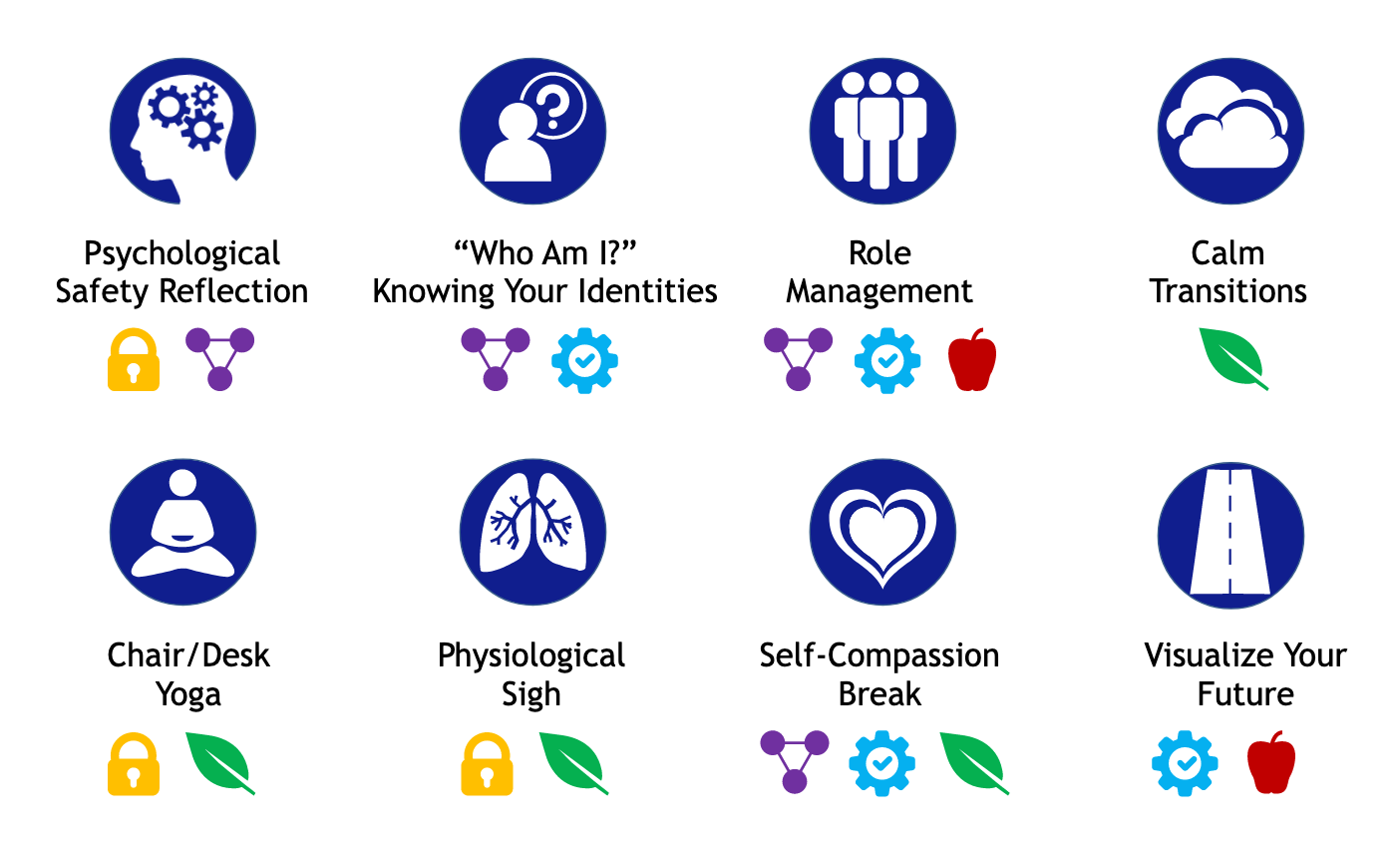
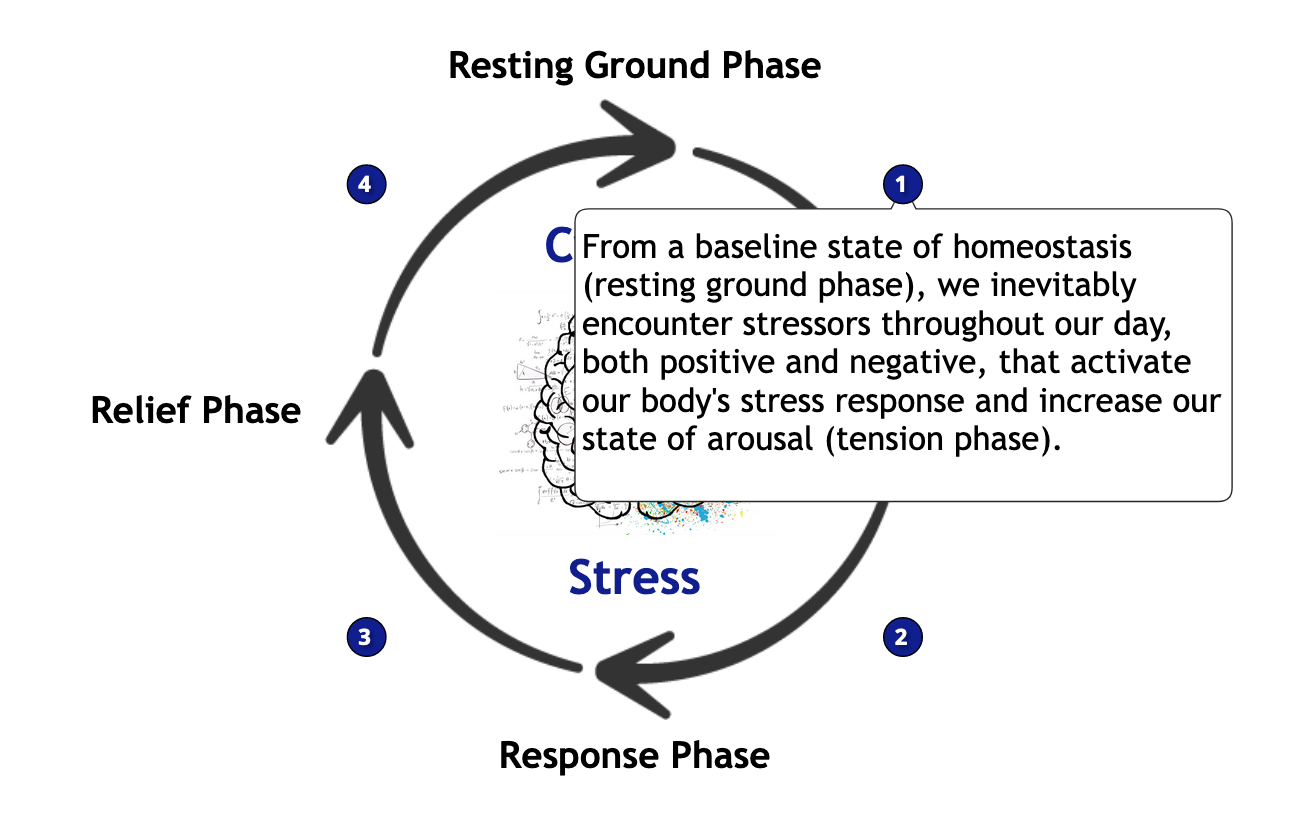

The Process
When this project began in January, I had completed three courses in the University of Colorado Denver's Master of Arts in Learning Design & Technology (LDT MA) program, and I was just starting my third semester. As a result, while I had certainly acquired some excellent foundational knowledge through this coursework, my skills were still relatively limited, and I had no prior experience working on a project in the "real world" of instructional design. I had never worked with a client or subject matter expert, I had never designed and developed a course from start to finish, and I was completely new to every tool I ended up using to create the training (largely Rise 360, Storyline 360, Adobe Illustrator, Camtasia, and Cluelabs). So needless to say it was a bit of a learning curve! For this reason, the beginning of the project was primarily spent getting myself organized and oriented to the process, researching the course topic, and training myself on the basics of the course authoring tools that would be used.
Prior to meeting with my subject matter experts, Mandy and Leslie, I went through their entire Past the Pandemic course, took extensive notes, and created a concept map in Canva as a jumping-off point for our first discussion. As you can see below, this map grew and evolved as we assessed and planned our content, and it ended up being a great low-stakes way of building trust and rapport with each other while working through the awkwardness of the initial Forming and Storming stages of group development (as described by Bruce Tuckman).
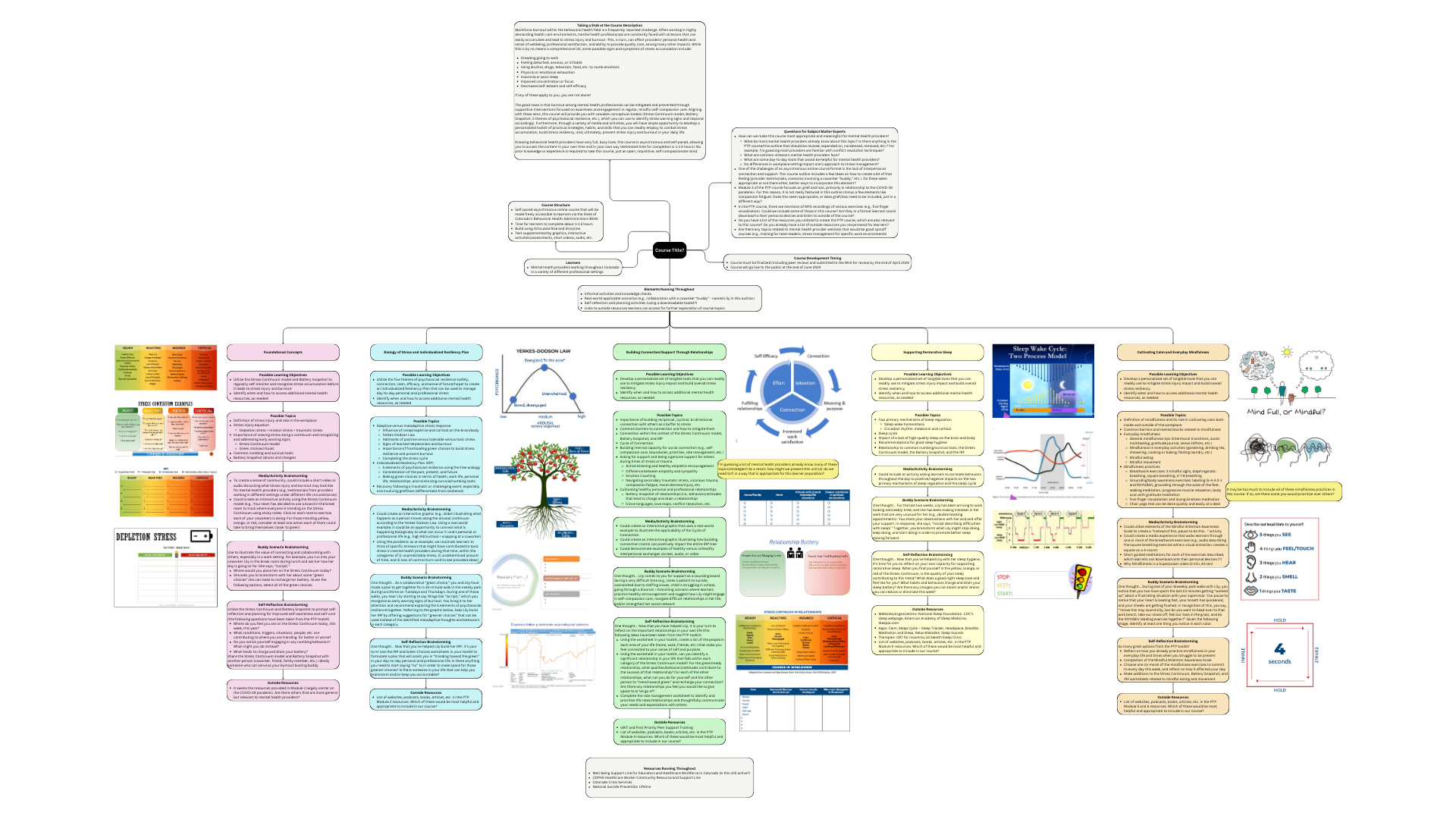
Through this process, I spent time researching our target learner population (behavioral health providers working in Colorado) and collaborated with Mandy and Leslie on writing a preliminary set of learning objectives to guide our approach to the course. Driven primarily by principles of Backward Design and ADDIE, I did my best to structure our design and development process in a way that felt organized and supportive to our goals, primarily through Review 360 and collaborative documents in Microsoft Teams. However, I would be lying if I said this unfolded in a way that was entirely linear and streamlined. Because of my inexperience working with instructional design frameworks and the various tools and software that were used in the project, there were definitely a few times I had to change course when I realized a certain activity was not possible, or there was a much better way of approaching a particular learning objective. While these shifts in direction no doubt led to inefficiencies in my process, they were fantastic learning experiences for me, and it was empowering to learn I can bounce back from them, especially when working as part of a supportive, collaborative team. It's all part of the learning process, right?

The Outcome
Once I completed the course, it was submitted for review by an outside instructional designer, as well as four additional subject matter experts assigned by the BHA. Though intimidating, this process ended up being quite informative, and Ben was instrumental in helping me navigate the muddy waters of receiving varied and sometimes conflicting feedback. After taking some time to consider, prioritize, and address the most beneficial comments, I asked Mandy and Leslie to confirm the accuracy of those changes, and the course was officially handed over to the BHA for its final quality assurance test before publication. In fact, if all goes well, it is expected to be released to the public tomorrow!
As I reflect on this accomplishment and the hard work that went into it from everyone on my team, I can't help but feel grateful that I got to be a part of this experience. When I think about where I was when I started the project and where I am now, it is amazing to look back and see how much I have gained in terms of my technical skills, as well as my abilities and confidence with navigating the instructional design process. While I still have SO much more to learn, I am excited to take these newfound skills and lessons on board when I jump into my next e-learning assignment, where I will inevitably make and learn from even more mistakes. In particular, I would like to practice, assimilate, and employ the following ten takeaways.
Takeaways by Stephanie FosterWhere will all of this take me next? Who knows... I am excited to find out!

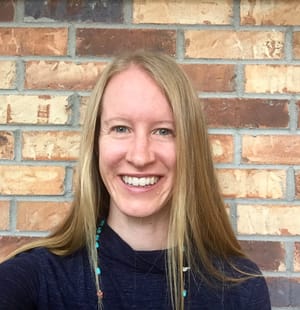







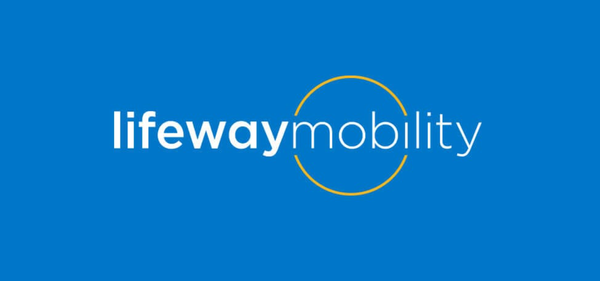




Member discussion